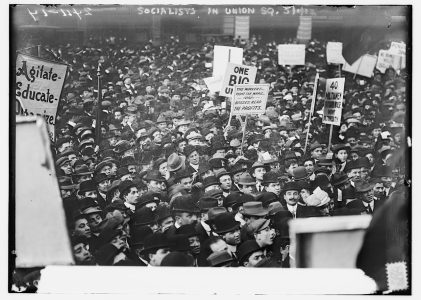First translation of Clara Zetkin, ‘Twenty-Five Years’, Die Gleichheit, April 29 1914)
The fighting proletariat’s international May Day celebration is just around the corner. This year, for the twenty-fifth time, the exploited of all countries, united in one purpose and one goal on one day, will declare irreconcilable war and mortal enmity on bourgeois society. In the past twenty-five years, how often have we heard the beneficiaries, eulogists and defenders of this bourgeois society predict ‘the end’ of May Day? When the momentous first congress of the new Socialist International in Paris in 1889 decided to launch May Day, when its slogan was received with indescribable enthusiasm by the class-conscious workers of all countries, a spooky hand appeared before those rulers to write their doom on the walls of the ornate social edifice of capitalism itself. The fear of a guilty conscience and their lack of historical understanding made these people think that May Day was tantamount to an attempt to bring about the ‘great collapse’.
After the actual events of the first international rally put paid to such childish imaginings, hardly a year has passed without the bourgeois newspapers more or less loudly and derisively proclaiming the failure of May Day. But lo and behold! The fighting working class’s international demonstration for the legal protection of workers and especially the eight-hour day, for generous social reform across the board, for the solidarity of the exploited of all countries and against the armaments madness and genocide, is still alive and kicking today. We concede that May Day did not bring to fruition all the great dreams that many had placed on it. However, what does this reveal other than the old, commonplace truth that in the proletariat’s struggle for liberation there is no single measure that can achieve far-reaching successes which must not be won in the face of the resistance of the capitalist world in a tenacious struggle? In the first 25 years of its existence, May Day has proved to be an excellent way of awakening and uniting the masses that are enslaved and sucked dry by capital, as well as of leading them into struggle against the exploiters and the exploitative capitalist order. And what it has achieved for all this in every single year and in every single nation has been all the richer, the more strength, enthusiasm, sacrifice and self-confidence that the organized vanguard of the working class has called upon to bring the idea of May Day to life.
The annual international march of proletarian masses can indisputably claim much of the credit for the fact that in all capitalist states the rulers and governments have been forced to abandon the old sacred principle of capitalist freedom of exploitation: laissez faire, laissez passer. Today, only the most backward scholars, politicians and legislators occasionally dare to summon the ghost of this principle. The international cooperation of governments in matters of worker-protection legislation may still produce sparse and sour fruits, but not even these could be harvested if it were not for the persistent, ever-recurring insistence of exploited men and women that they be protected from their callous tormentors. The hostility of the most powerful capitalist cliques towards legal protection for workers, towards social and political reforms in general is not declining; on the contrary, it is intensifying. Not that the big businessmen have to weep for dwindling profits or the ‘ruin of industry’ as a result of such progress. Experience has long since proved that the curbing of capitalist greed for profit and the improved position of the proletariat increases the efficiency of the working people and promotes the development of the forces of production. However, what the capitalists are trembling about is being disrupted and restricted from being the ‘masters of their house’. They fear the growing consciousness and assurance of their wage slaves in the struggle for reforms and through reforms. And it is precisely the consciousness and assurance of those on the front that has been awakened and strengthened by the mass march of the workers’ battalions of all countries on May Day.
For this international demonstration is and remains a passionate appeal to the have-nots to remember their humanity and not to allow it to be crushed in the profit mills of capitalism without a fight; it is and remains a tangible embodiment of the importance and the power that lies within the proletariat. That is why the proletarians’ struggle for better working conditions, for an easier, richer existence, has received ever greater inspiration thanks to May Day, reaching ever larger strata of the population. Thousands of May Day demonstrations sent out an urgent warning to the workers not to be content with pushing forward social legislation, but to use the trade unions to defend themselves against the capitalist squandering and destruction of human life. The attention of the broadest masses was drawn to the necessity of the organisations carrying out a wide range of work. So it is that, in the past 25 years, May Day has been a major and successful recruitment day for social democracy and the trade unions.
It has made an indelible contribution to reviving and strengthening the consciousness of international solidarity among proletarians in all countries. Since the international proletariat first gathered around the socialist may pole, imperialism has only grown. In a mad frenzy, the propertied and ruling classes are squandering the great wealth and blood of the people in exorbitant arms spending, in murderous colonial adventures and in atrocious wars. The danger of a world conflagration constantly threatens all peoples. In the midst of the capitalist witches’ sabbath of murderous patriotic rabble-rousing, May Day raised the ideal of the international brotherhood of the exploited year on year. It has awakened in millions the deepest hatred of war between fraternal peoples, has reminded millions of the power they can wield against this barbarism. May Day in one single year has thus done more for world peace than all the congresses of the bourgeois friends of peace have. It has done more than all the meetings of parliamentarians of different nations, where bourgeois politicians kiss the hem of the robe of the goddess of peace, only then to sharpen the sword of imperialism immediately by voting through spending on arms. Without the 25th anniversary of May Day, we could not imagine the powerful peace rally of the international proletariat recently held in Basel, the increasingly clear and powerful stand of workers from all countries against militarism and war. All the worries and needs that beset the working people, all the demands and goals that are currently being raised to the fore in their struggles, have been put to good use by May Day in line with the tasks of the hour. Above and beyond individual and small grievances, however, May Day has always directed the attention of the masses to the one great root of all social evil: the absence of economic freedom for workers, the exploitation of man by man. It has thus concentrated the will of the working people on the social revolution, on the ultimate socialist goal.
Because May Day draws its strength from all the current suffering and future hopes of the exploited, it has become an inspiration and a guiding light for hundreds of thousands of proletarian women. At the Paris Congress of 1889, the Social Democratic women of Germany were represented by two delegates at a major international conference of the proletariat for the first time. Back then, the weak beginnings of their organization were still struggling to find light and warmth for further development, not least with all the perils of the Anti-Socialist Law [1878-1890] and other difficulties. Thanks to the success of [International] Women’s Day and the Red Week, the number of organized women party members is likely to approach 200,000 this year. A woman has been a member of the party executive for years, and another is a member of the [SPD’s] Control Commission; as far as the female sex’s lack of political rights does not prevent it, female comrades are members of all the working bodies and leading organisations of social democracy. The Third International Socialist Women’s Conference will take place this summer, with the initiative for these conferences coming from female comrades in Germany. The 25th anniversary of May Day has also been significant for this impressive development. Streams of knowledge and enthusiasm have spread among the female proletariat from the May Day demonstrations themselves. Our women comrades will joyfully devote all their energy to ensuring that this year’s May Day grabs the attention of further crowds of women workers and workers’ wives, ensuring that it proves to be a brilliant showing of the proletariat’s freedom fighters rallying to overthrow the bourgeois order. Our slogan for this May Day is not to disarm, but to arm ourselves more effectively. All the good things we read these days about the proletarian mass rally of May Day must not become an honourable epitaph. We do not want to hear that May Day is a thing of the past. It is a thing of the present.


